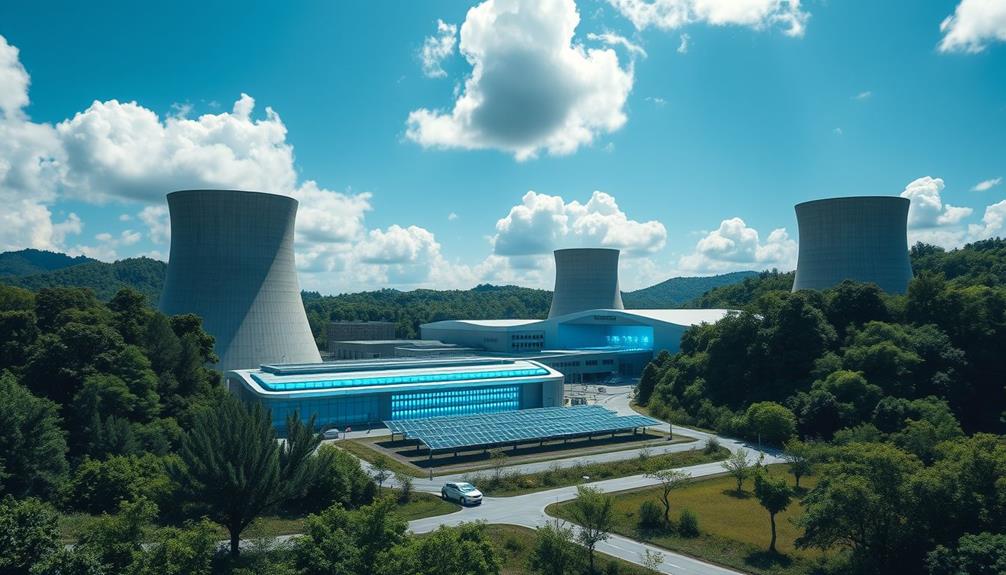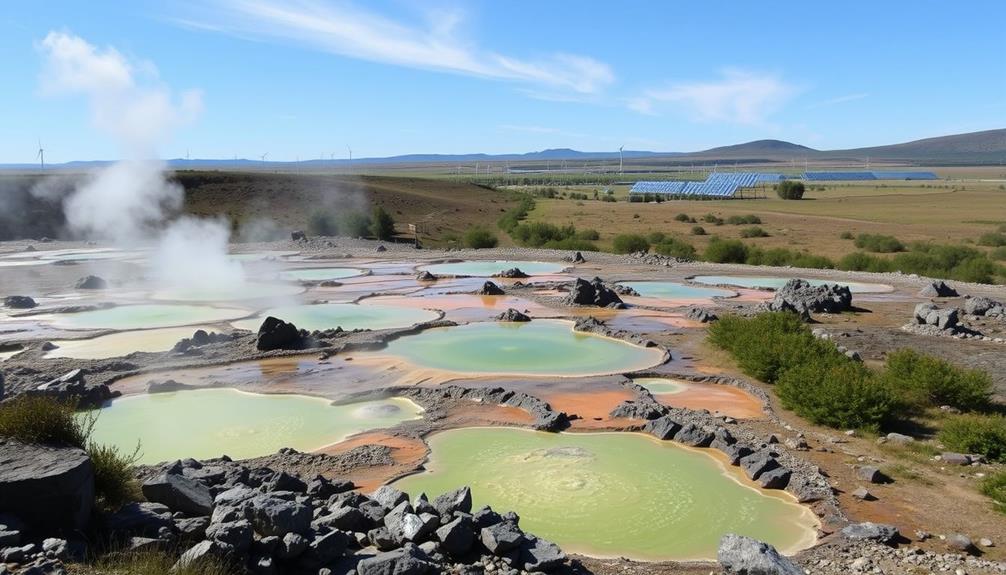The future of renewable energy looks bright with sources like solar, wind, and nuclear leading the charge. You're likely to see solar power capitalize on declining costs and expand considerably. Wind energy's job creation and minimal environmental impact are remarkable, while nuclear offers high output with zero carbon emissions. Hydroelectric power remains reliable and efficient, tapping into water flow for energy. Biomass and geothermal are viable options too, utilizing organic materials and Earth's natural heat. If you're curious about the challenges and innovations shaping these energies, more insights are just ahead.
Key Takeaways
- Solar and wind energy are driving significant growth in renewable sources, projected to supply up to 90% of global electricity by 2050.
- Nuclear energy offers high efficiency and zero carbon emissions, positioning it as a clean and reliable energy source for the future.
- Hydroelectric power is efficient and stable, providing consistent energy generation while reducing reliance on fossil fuels, despite ecological impacts.
- Wind energy has seen a dramatic cost decrease, creating thousands of jobs and generating clean power with minimal environmental impact.
- Emerging technologies like geothermal and wave energy present sustainable alternatives, although they face challenges in cost and resource availability.
Overview of Global Energy Production
In recent years, global energy production has been heavily influenced by fossil fuels, which accounted for a staggering 80.9% of the total energy supply in 2019. Oil fueled 30.9%, coal contributed 26.8%, and natural gas made up 23.2% of the energy mix.
Despite this heavy reliance, renewable energy sources are starting to gain momentum. Among these, choosing a solar panel is becoming an essential consideration for many households and businesses. However, they still represented a modest share, with nuclear energy at 5.0%, hydroelectricity at 2.5%, and biomass at 9.4%.
Among renewable sources, solar and wind energy are the stars of the show, driving 95% of global renewable energy expansion. Yet, as of 2019, they only contributed 2.2% to the overall energy supply. This highlights the significant gap that still exists in harnessing their full potential.
Looking ahead, the International Renewable Energy Agency (IRENA) projects that renewables could provide up to 90% of global electricity by 2050. Embracing these technologies is vital for reducing carbon emissions and improving energy security.
As you consider your role in this shift, remember that diversifying energy sources not only benefits the environment but also strengthens economies worldwide.
Nuclear Energy

When you think about energy efficiency, nuclear energy stands out, producing nearly twice the energy of natural gas or coal plants.
Additionally, advancements in technologies related to heat pump efficiency are also contributing to more sustainable energy solutions.
However, with great output comes the responsibility of ensuring safety, as operational risks and radioactive waste must be carefully managed.
As technology advances, new reactor designs promise to enhance both safety and viability for the future.
Efficiency and Output
Nuclear energy consistently proves to be the most efficient method for electricity production, generating nearly twice the energy of natural gas or coal plants. Its efficiency is unmatched, as it delivers three times more energy than wind and solar sources. This significant output potential positions nuclear energy as a key player in the shift to cleaner energy systems.
Additionally, the use of nuclear energy can contribute to psychological benefits of achieving weight loss milestones, as reduced reliance on fossil fuels can enhance overall public health and environmental quality.
With zero carbon emissions, nuclear energy stands out as one of the cleanest renewable sources available today. This characteristic is essential in the fight against climate change, allowing you to contribute positively to environmental sustainability while meeting energy demands.
As global reliance on nuclear energy continues to grow—accounting for about 5% of the total energy supply in 2019—its role in future energy strategies becomes increasingly significant.
Safety Measures Required
Safety in nuclear energy production is vital, as it directly impacts public trust and environmental integrity. While nuclear energy produces zero carbon emissions, it requires stringent safety measures to mitigate risks associated with potential accidents and radiation exposure. Historical incidents like Chernobyl and Fukushima have shown us the importance of these precautions.
Additionally, advancements in technology, such as AI enhances accuracy in medical diagnoses, can also be applied to monitor and manage nuclear safety systems, guaranteeing that potential issues are identified and addressed promptly.
To guarantee safe operation, nuclear plants are equipped with multiple redundant safety systems, including robust containment structures and emergency cooling systems. These are designed to prevent any radiation release in case of a malfunction.
It's also essential that plant personnel undergo regular safety drills and thorough training, mandated by regulatory bodies, to prepare for emergencies and respond effectively.
Advanced reactor designs, such as Generation IV reactors, improve safety features by incorporating passive safety systems that function without human intervention or external power sources.
Moreover, continuous radiation level monitoring and strict oversight from organizations like the Nuclear Regulatory Commission (NRC) play vital roles in maintaining safety standards.
Hydroelectric Energy

How does hydroelectric energy stand out as a leading renewable resource? It harnesses the flow of water, primarily through dams, making it one of the most efficient and cost-effective sources of energy available.
In the United States, you're looking at the second-largest producer of hydroelectric power, averaging an impressive 40 billion kilowatt-hours annually over the last decade. This reliable energy source is independent of weather conditions, thanks to reservoirs created by hydroelectric dams that help control river flow.
Additionally, the stability of hydroelectric energy production can provide a consistent energy supply, which is essential for supporting modern infrastructure and reducing reliance on fossil fuels importance of financial planning during divorce.
However, while hydroelectric energy is a renewable resource, it's important to take into account its ecological impacts. The construction and operation of dams can disrupt habitats and displace communities, raising significant environmental concerns.
The Bureau of Reclamation plays a significant role in this landscape, managing around 500 dams and over 300 reservoirs in the U.S., contributing substantially to the country's hydropower production capabilities.
Wind Energy

When you consider wind energy, think about its impressive economic benefits and low environmental impact.
With the cost of onshore wind energy dropping considerably, it's becoming a leading choice for clean power.
Additionally, implementing best practices in software quality assurance can enhance the efficiency of energy systems, ensuring they operate at peak performance.
Plus, as wind farms expand, they not only generate electricity but also create thousands of jobs, making them a win-win for both the economy and the planet.
Economic Benefits of Wind
Wind energy is transforming the landscape of renewable energy, offering significant economic benefits that can't be ignored. As one of the most cost-effective renewable sources, the cost of onshore wind power has decreased by 56% from 2010 to 2020, making it competitive with fossil fuels. This drop in cost opens doors to more investments and projects.
Additionally, a holistic lifestyle that includes renewable energy can contribute to improved overall wellness and community health.
You'll be excited to learn that the projected creation of over 44,000 jobs in offshore wind by 2030, along with an extra 33,000 community jobs, highlights the economic potential of wind energy initiatives. Each dollar invested in wind energy generates three times more jobs compared to fossil fuel investments, showcasing its economic advantages in job creation.
Moreover, wind farms not only provide clean energy but also additional revenue streams for landowners who lease their land for turbine installations, positively impacting local economies.
The scalability of wind energy allows for vast offshore projects that can power hundreds of thousands of homes and businesses. By investing in wind energy, you're not just supporting a greener future; you're also fostering job growth and economic stability in your community.
Environmental Impact Assessment
The environmental impact assessment of wind energy reveals a promising picture for sustainable power generation. As you explore wind power, you'll find it's a clean and renewable source that doesn't produce harmful emissions during operation, greatly reducing air pollution and its associated health risks.
However, it's crucial to evaluate potential drawbacks. The construction and operation of wind farms can pose risks to local wildlife, particularly birds and bats, with studies indicating millions of avian fatalities annually.
Despite these concerns, wind energy's overall environmental impact remains comparatively low. Unlike fossil fuels, which require extensive water resources for cooling and extraction, wind power generates electricity without consuming water. Additionally, wind turbines boast a recyclable rate of 80-90%, although current limitations often lead to blades ending up in landfills. Companies like VESTAS are researching composite recycling to improve this situation.
Offshore wind farms, in particular, tend to minimize impacts on terrestrial ecosystems while offering economic benefits through job creation. They also maintain a lower visual and noise disturbance than onshore installations.
Biomass Energy

Biomass energy offers a promising solution to our growing energy needs, as it harnesses organic materials like plant and animal waste. This renewable source has a relatively quick regeneration rate, making it an appealing alternative to fossil fuels.
By cultivating biomass, you can help reduce waste in landfills by repurposing organic materials, which contributes to effective waste management solutions. Additionally, utilizing biomass aligns with the principles of natural wellness practices that emphasize sustainable living and environmental responsibility.
However, it's crucial to manage emissions carefully when burning biomass. While it can provide a flexible energy solution depending on the feedstock used, burning biomass produces greenhouse gases, including methane. To minimize environmental impacts, you'll need to adopt sustainable practices and monitor emissions closely.
The sustainability of biomass energy hinges on proper management. If you guarantee that feedstocks are replanted at a sustainable rate, biomass remains a renewable source.
But if over-harvesting occurs without adequate replanting, it can quickly become non-renewable. Additionally, cultivating biomass may require significant land and water resources.
Geothermal Energy

Geothermal energy taps into the Earth's natural heat, offering a sustainable way to meet up to 12% of our global heating, cooling, and electricity needs. This renewable energy source stands out for its minimal carbon emissions, making it an environmentally friendly option for energy production.
Additionally, just as with the complexities involved in relationships with BPD-coded characters, the management of geothermal resources requires a nuanced approach to guarantee long-term sustainability. However, it does come with challenges that you should consider.
- High upfront costs can be a barrier to wider adoption.
- Geothermal resources are often location-specific, primarily found in volcanic regions.
- While it has low emissions, careful management is necessary to minimize greenhouse gas release.
- Long-term efficiency often outweighs initial investments.
Despite these challenges, geothermal energy has significant potential. With careful planning and investment, you can help harness this powerful resource.
As technology advances, more regions may become viable for geothermal energy production, expanding its reach. By embracing geothermal energy, you not only contribute to a sustainable future but also play a part in reducing our reliance on fossil fuels.
It's an exciting time to explore how geothermal energy can play a vital role in our renewable energy landscape.
Wave Energy

Harnessing the power of ocean waves, wave energy offers a promising avenue for renewable electricity generation. This technology captures the movement of ocean waves, tapping into a significant, yet largely untapped, potential for renewable energy, especially in coastal regions.
With the growing popularity of water parks in coastal areas, such as those in Sarasota, families can enjoy thrilling attractions while also witnessing the advancements in sustainable energy practices through local initiatives like eco-friendly practices. The Bureau of Ocean Energy Management (BOEM) has taken a notable step by issuing the first wave energy research project lease on the West Coast, paving the way for broader utilization of this clean energy source.
One of the greatest advantages of wave energy systems is their ability to produce electricity with zero harmful emissions during operation, contributing to a more sustainable energy landscape.
However, the development of these technologies isn't without challenges. High installation costs and the need for specific oceanic conditions can limit their current application.
Fortunately, ongoing research and demonstration projects supported by the National Renewable Energy Laboratory are essential for advancing wave energy analysis and technology testing.
As you explore the potential of wave energy, consider how this resource could play an essential role in the shift toward a cleaner, more resilient future in renewable energy. Embracing this technology can help you harness the ocean's power for generations to come.
Conclusion
As we stand on the brink of an energy revolution, embracing these promising renewable sources will light the way to a sustainable future. By harnessing the power of the sun, wind, and water, we can transform our energy landscape and protect our planet for generations to come. So, let's roll up our sleeves and plunge into this green wave of opportunity; the future is bright, and it's ours for the taking.








